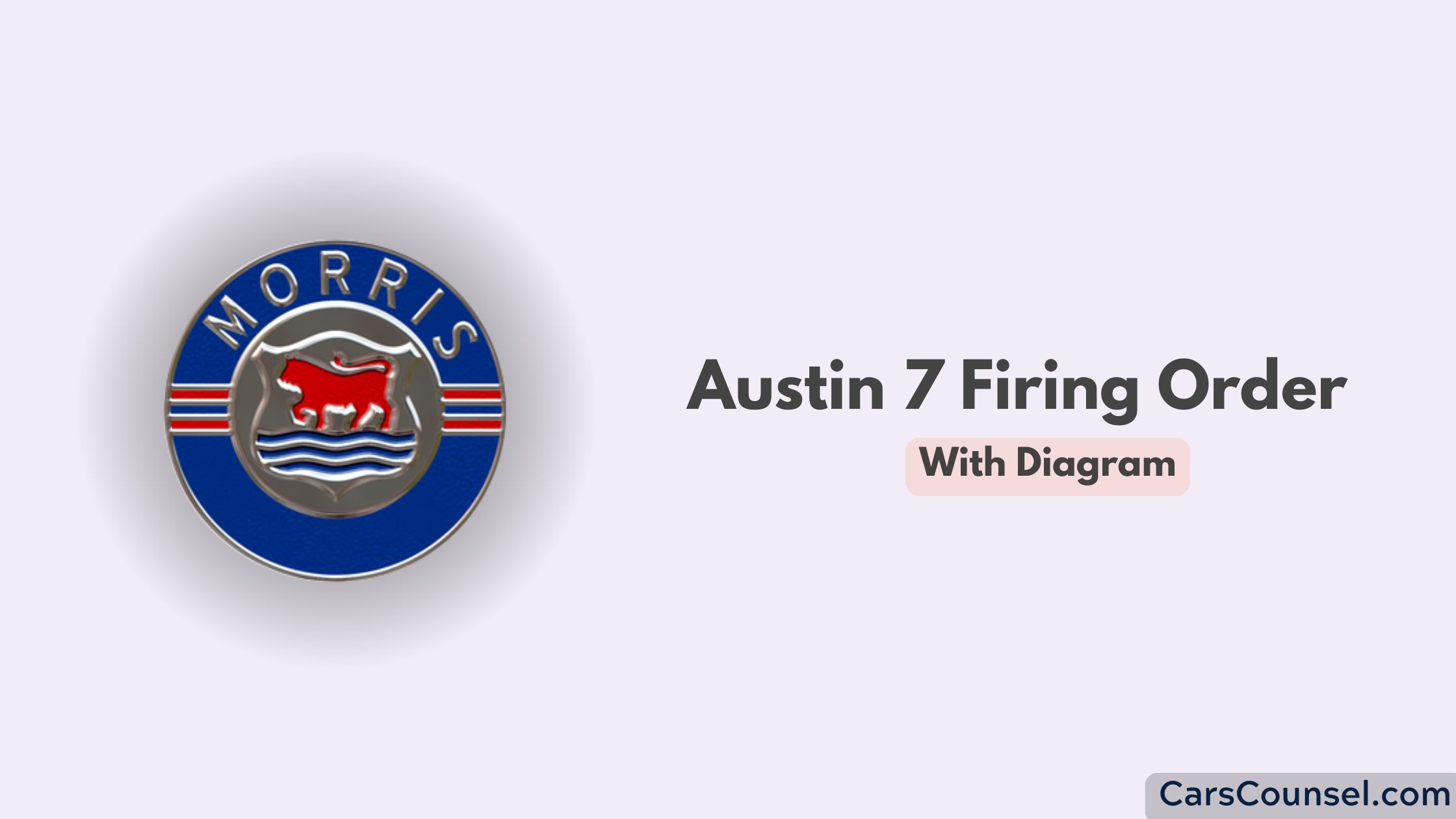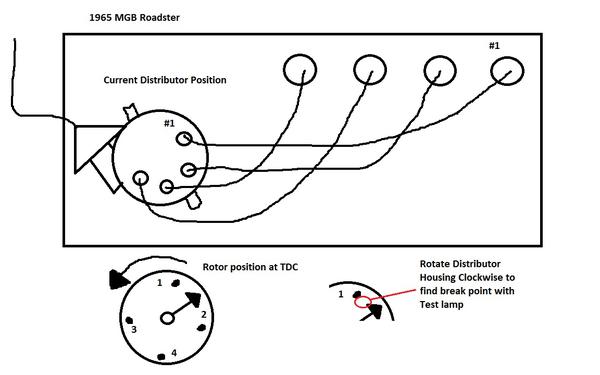The Austin 7, often referred to as the “Baby Austin,” is an iconic small car produced by the Austin Motor Company from 1922 to 1939. Compact, lightweight, and affordable, the Austin 7 revolutionized motoring in its era and became a beloved classic.
The firing order is at the heart of its engine’s reliable operation, a critical aspect that ensures smooth and efficient performance.
This article provides a detailed explanation of the firing order for the Austin 7, why it’s important, and how it contributes to the car’s overall functionality. Whether you’re restoring an Austin 7 or curious about its engineering, this guide will explain it to you.

Quick Navigation
The Austin 7 Firing Order
The firing order for the Austin 7 engine is: 1-3-4-2

How the Firing Order Works
- Cylinder 1 Fires First: The frontmost cylinder initiates the combustion cycle.
- Cylinder 3 Fires Next: Ignition moves to the third cylinder, skipping the second.
- Cylinder 4 Fires Third: The rearmost cylinder ignites after Cylinder 3.
- Cylinder 2 Fires Last: The second cylinder completes the cycle, returning the sequence to Cylinder 1.
This pattern ensures that the combustion events alternate effectively between the cylinders, providing a smooth and balanced operation.
Why the 1-3-4-2 Firing Order Works for the Austin 7
The 1-3-4-2 firing order was chosen for the Austin 7 engine due to its mechanical and operational advantages:
- Balance: Alternating between non-adjacent cylinders reduces stress on the crankshaft and minimizes vibrations.
- Efficiency: Proper spacing between ignition events ensures complete combustion, maximizing power output.
- Simplicity: The design works seamlessly with the inline-4 configuration, which has fewer moving parts than other engine layouts.
- Durability: The balanced firing sequence helps prevent premature wear and tear on internal components.
What Is a Firing Order?
The firing order refers to the specific sequence in which the engine’s spark plugs ignite the air-fuel mixture in the cylinders. This ignition generates the power that drives the car. The firing order is carefully designed to optimize performance, balance engine operation, and minimize vibrations.
Why the Firing Order Is Crucial
- Smooth Engine Operation: Ensures consistent power delivery and reduces vibrations.
- Performance: Proper sequencing allows the engine to deliver efficient and reliable power output.
- Durability: Distributes stress evenly across the crankshaft and internal components, extending engine life.
- Efficiency: Promotes complete combustion, improving fuel economy and reducing waste.
Overview of the Austin 7 Engine
The Austin 7 is powered by a four-cylinder inline engine, which was compact yet practical for its time. Several variations of the engine were produced, but the fundamental layout remained the same throughout its production years.
Engine Configuration
- Inline-4 Design: Four cylinders arranged in a straight line, making it simple and efficient.
- Overhead Valve (OHV) or Side Valve: The engine may have either configuration, depending on the model and year.
- Cylinder Numbering: Cylinders are numbered sequentially from the front of the engine to the rear.
Identifying the Firing Order
Knowing the firing order of the Austin 7 is essential for maintenance, tuning, and troubleshooting. Here’s how you can identify and verify the firing order:
Owner’s Manual
The owner’s manual for the Austin 7 provides detailed specifications, including the firing order and cylinder layout.
Cylinder Markings
Cylinder numbers are often marked on the engine block or the spark plug wires, making it easier to identify the sequence.
Repair Manuals
Classic car repair manuals include diagrams and instructions for understanding the Austin 7 engine layout and firing sequence.
Symptoms of Incorrect Firing Order
If the firing order is incorrect, the engine will exhibit several noticeable symptoms. These problems can affect the performance and reliability of the Austin 7.
Common Symptoms
- Engine Misfires: The engine struggles to fire properly, causing inconsistent power delivery.
- Rough Idling: The engine vibrates excessively or feels unstable when idling.
- Loss of Power: The car may have difficulty accelerating or maintaining speed.
- Unusual Noises: Knocking, pinging, or backfiring sounds may occur due to incorrect timing.
- Increased Fuel Consumption: Inefficient combustion results in higher fuel usage and emissions.
Causes of Incorrect Firing Order
- Misconnected Spark Plug Wires: Spark plug wires routed to the wrong cylinders disrupt the firing sequence.
- Timing Issues: A misaligned distributor or worn timing chain can throw off the ignition sequence.
- Faulty Components: Damaged spark plugs, ignition coils, or distributor caps may interfere with proper ignition timing.
Diagnosing and Fixing Firing Order Problems
If you suspect issues with the firing order, follow these steps to diagnose and correct the problem in your Austin 7:
Diagnostic Steps
- Inspect Spark Plug Wires: Verify that each wire is connected to the correct cylinder in the 1-3-4-2 sequence.
- Check the Distributor: Ensure the distributor rotor aligns with the correct spark plug wire at the appropriate time.
- Use a Timing Light: Confirm that the ignition timing matches the manufacturer’s specifications.
- Perform a Compression Test: Verify that all cylinders have adequate compression for proper combustion.
Fixing Common Issues
- Reconnect Wires: Correctly route the spark plug wires to the appropriate cylinders based on the firing order.
- Replace Faulty Components: Install new spark plugs, distributor caps, or ignition wires if they are worn or damaged.
- Adjust Timing: Realign the distributor or timing chain to restore proper synchronization.
Preventative Maintenance for Firing Order Reliability
Maintaining the correct firing order is essential for ensuring the Austin 7 engine operates smoothly. Follow these preventative measures to avoid problems:
Regular Inspections
- Check the condition of spark plugs, ignition wires, and distributor caps during routine maintenance.
- Look for signs of corrosion, wear, or loose connections.
Replace Components as Needed
- Replace spark plugs and ignition wires at intervals recommended for vintage engines.
- Use high-quality components that match the specifications of the Austin 7.
Keep the Timing System in Check
- Periodically inspect the timing chain or belt for wear and proper alignment.
- Adjust the distributor as needed to maintain accurate ignition timing.
Engines with Similar Firing Orders
FAQs About the Austin 7 Firing Order
Can the Firing Order Be Changed?
No, the firing order is fixed by the engine’s design and crankshaft configuration. Altering it would require significant mechanical modifications.
What Happens If the Firing Order Is Incorrect?
An incorrect firing order can cause misfires, rough idling, power loss, and potential damage to the engine’s internal components.
How Can I Verify the Firing Order?
Refer to the owner’s manual or a repair guide, and use cylinder markings or diagnostic tools to confirm the ignition sequence.
Is the Firing Order the Same for All Inline-4 Engines?
While many inline-4 engines use the 1-3-4-2 firing order, variations may exist depending on the manufacturer and engine design.
Conclusion
The 1-3-4-2 firing order is a fundamental aspect of the Austin 7 engine, ensuring smooth performance, balanced operation, and reliable combustion. By understanding this firing order, you can confidently maintain and troubleshoot your classic Austin 7, preserving its legacy for years to come.
Whether you’re tuning the engine, addressing performance issues, or simply learning about its mechanics, knowing the firing order is a key step in mastering the art of Austin 7 restoration and care. With proper maintenance and attention, this iconic car will continue to bring joy to enthusiasts and drivers alike.

